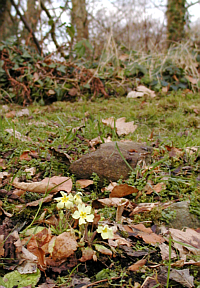Last April I had some All Fools Day fun with a photograph of a very exotic butterfly sitting on a bunch of primroses in our garden. This was in response to a front-page story in the Independent headed ‘How the blurring of the seasons is a harbinger of climate calamity’. The article claimed that the somewhat archaic science of phenology is a reliable method of detecting dramatic changes in the climate.In Victorian times it became fashionable to keep a natural history diary in which observations of any curiosities noticed on country walks or around the garden were noted. Of course first flowering dates were recorded together with other information about plants, birds and of course the weather. As such records proliferated they were collated and analysed. From this material the science of phenology developed: the study of recurring natural phenomena such as the onset of each season of the year.
During the twentieth century interest in phenology waned although the Royal Meteorological Society collected data until 1948. The reason for this fall from favour has been explained by Philip Eden, a vice-president of the RMS:
Plants and animals are, of course, affected by the weather, but they are affected by other things too. Information collected about flowering dates, hibernation times, the arrival and departure of snow and ice, are all called ‘secondary data’ or ‘proxy data’ by climate experts.
All these secondary indicators are affected by other factors such as human intervention, genetic modification, pesticides, fertilisers, pollution, and complex interactions with other elements of a changing ecology. Some of them respond to climate change with a delay of years or even decades.
Philip Eden, A Change in the Weather, p 188-9
But with the advent of concern about global warming, phenology has been revived. Over the last few years an ecologist called Dr Tim Sparks has been responsible for numerous stories in the media about early flowering dates, mushrooms that appear when least expected, and even the extension of the grass cutting season. Most recently he forecast that the UK would have its first ‘green Christmas’ this year, with leaves still on the trees. His research has, of course, been presented as incontrovertible evidence of man-made global warming, in spite of what the Royal Meteorological Society might think, and news media like The Independent and the BBC have been very happy to report his findings in these terms.

Back in October, I noticed that a single clump of primroses some distance from our kitchen window were in flower. By the beginning of November, this plant had still not decided to take a well-earned winter rest, and my heart sank at the thought of what Dr Sparks might say about such a phenomenon. Would he conclude that global warming has now reached a stage when winter has been abolished altogether?
In mid-November, snow began to accumulate on the hills behind our house, an event that no one I spoke to could remember happening so early in the winter for very many years. This continued until early December when a warmer rainy period caused a thaw. The winds that came with this stormy interlude also took care of the last few remaining leaves on the trees.
Since late-December we have had continuous hard frosts, a most unusual event here. Our garden is close to the sea and has an open and sunny aspect, which makes it almost frost-free. So imagine my surprise when I noticed at New Year that the clump of primrose flowers still had not succumbed to what is becoming a notably hard winter. Since then the frosts have intensified with temperatures of – 4°C (25°F) becoming commonplace, and one night the thermometer recorded – 6°C (21°F). The primrose plant seemed to thrive on this, with even more flowers appearing.
As anyone who lives in the countryside knows, such anomalies are not unusual. When I was a child in Sussex we usually managed to find a primrose in flower on a New Year’s day walk, but you had to rummage around in the hedgerows a bit to do so. This did not mean that the flowering season for primroses had started of course; it would be many weeks before that happened. Such blooms were just an interesting curiosity and a welcome reminder that spring would eventually come with the joy of seeing the banks and verges carpeted by fragrant yellow flowers.
I’m not a botanist, and I have no idea what has caused this particular plant to behave in such a strange way, but it seems safe to assume that temperature, and an early onset of spring, has absolutely nothing to do with it.
By a strange coincidence, I suspect that this is the same plant that I photographed the long-dead Indian butterfly on in April, but this time there has been no slight of hand. The image above is genuine and was taken this morning.

The latest primrose I’ve seen and photgraphed, was on Inishfree when we lived there – on 9th November.i997.
Hard frosts were the norm in Glamorgan in October, they would see off the Nasturtiums. This would have been the sixties.
Don’t take it amiss but it’s “How this blog got its name”.
“It’s” always means “it is” and never otherwise.
TonyN: All corrections gratefully received!